Written by Ben Kurata
Why train on steel?
The shooter learns faster. Traditional cardboard or paper targets only give the shooter and the coach one feedback, visual. If the bullet holes on the target are not visible (example: 5.56 mm at 100 yards), then the shooter and the coach have to play instant recall to try and determine what the shooter did well and what needs improvement. There is often a delay of several seconds if not minutes before the shooter receives feedback on how (s)he did, and it is difficult if not impossible for the shooter to remember what the sight picture, grip, and trigger press looked and felt like for each and every shot.
Why does the shooter learn faster on steel?
Let’s assume that we are conducting handgun training at traditional handgun fight distances, 15 yards and closer. When training on steel, when the shooter hits, they receive immediate feedback not only visually (the strike of the bullet on the steel) but also auditory feedback (the distinct “ping”).
If the target is a reactive steel target, the shooter also gets the additional feedback of having the target fall or move.
I would also argue that at Close Quarter Combat distances feedback is so immediate that the shooter remembers what the sight picture, grip, and trigger press looked and felt like for each successful shot.
While coaching by the instructor on cardboard or paper tends to be diagnostic, I find that coaching by the instructor on steel tends to be faster and more immediate. (“On the second shot you pulled low and left,” etc. vs. “Low. Low. Hold higher.”) Rather than concentrating on the not so good shots, the shooter and the coach can concentrate on the HITS.
More than one experienced instructor / shooter has put forth the idea that feedback provided by shooting on steel is so immediate that it actually enters the subconscious mind faster than the conscious mind can process all of the stimuli associated with conscious sight picture, grip, trigger press, etc.1 I can speak from my own experience that based thousands of dry fire repetitions with tens of thousands of live fire rapid fire strings, when firing a semi-automatic pistol in rapid fire I am not conscious of sight picture or trigger press as traditionally defined. I am very conscious of the rear outline of the slide (as it is in constant motion), the feel of the pistol in my hands and the trigger reset. With traditional cardboard or paper targets I do not get any feedback until I shoot the pistol to slide lock or the pre-determined number of shots and lower the muzzle. When shooting on steel, I get immediate feedback on each and every shot I fire and if I don’t hear an immediate “ping” after firing a shot, I know that I didn’t hit, and I need to do something differently for the next shot.
In other words, as the student progresses in his/her skill level, (s)he starts correcting him/herself before the coach can diagnose and offer suggestions. At this level, the shooter becomes his/her own coach. I have found that with a little practice, any individual who is motivated enough can easily fire 4-6 rounds a second from a semiautomatic pistol and have all the rounds strike in an acceptable area of the target at 7 yards. When firing this rapidly, you can’t be consciously thinking of “front sight focus, surprise trigger break” for each and every shot or the rate of fire will drop to 1-2 shots per second.
So What?
Well, assuming that both the Officer and the armed assailant in a shooting encounter are equally motivated, would you rather be sending or receiving 4-6 hits per second?
When firing at this rate on steel targets, the auditory response takes third place in perception after the visual (the blur of the rear of the slide crossing into an acceptable target area) and the tactile (the reset and pressing of the trigger). The reason is, if you wait for the “ping” on the steel, you will have delayed your response time by about a half a second or 2 outgoing / incoming rounds. I learned a long time ago while shooting on the Action Target Dueling Tree or Plate Rack that if I waited for the “ping” of my first target, my opponent was usually hitting his second, or even third target. I learned to see an acceptable sight picture for the first shot, press the trigger and immediately shift my eye focus to the second plate while muzzle of the handgun, rifle, or shotgun was still lifting.
Another, more practical reason for trusting your first shot is that in a real-life encounter, you probably won’t hear a “ping” from your adversary. You may not see any immediate reaction at all. There can be many reasons for this. First, and most likely (about 80 – 85% of the time nationally), is the possibility that you missed the threat entirely. That is why we train, train, and train some more. The second reason is that you hit, but did not hit a part of your attacker’s anatomy that would trigger an immediate reaction. (If you have the opportunity to attend one of Dr. James William’s excellent seminars, “Shooting with X-ray Vision”, do so.) The third reason may be that you hit, but the caliber / projectile configuration just didn’t perform as advertised. All of the above are good reasons for training to shoot and hit fast and repeatedly, and the quickest way to do so is to shoot on reactive steel.
In a subsequent article, I will go over how to shoot on reactive steel safely.
Sources:
- Bank Miller, Conscious and Subconscious Training on Reactive Steel, The Firearms Instructor, Issue 47.







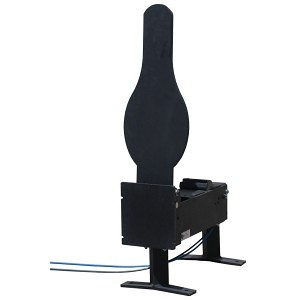
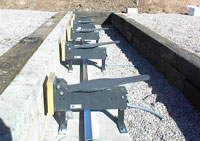
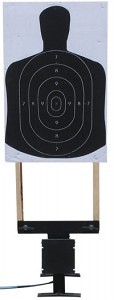 n range of 40 psi to 100 psi. It can also be triggered by a 12V signal of less than 60mA. The actuator uses 10.6 cubic inches of air per actuation. It utilizes a “proportional force” cam lifter system to control the reset action and lift action smoothly and reliably. The Auto-Popper is totally field repairable – a complete field rebuild operation can be done by standard range personnel using standard hand tools. The target plate is reversible and easily changeable.
n range of 40 psi to 100 psi. It can also be triggered by a 12V signal of less than 60mA. The actuator uses 10.6 cubic inches of air per actuation. It utilizes a “proportional force” cam lifter system to control the reset action and lift action smoothly and reliably. The Auto-Popper is totally field repairable – a complete field rebuild operation can be done by standard range personnel using standard hand tools. The target plate is reversible and easily changeable.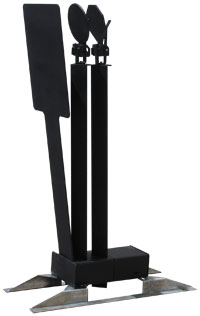 As we learn more and more about the human dynamics involved in armed confrontations, we understand that physical skills that require conscious thought or intellectual processing tend to break down rapidly under high levels of stress. If defensive skills and responses are not programmed in at a subconscious level, the sudden stress may cause us to fumble, freeze or panic. It is in this environment that reactive shooting skills are needed. Such reflexive shooting skills can be taught through the use of extremely short time limits, thus pushing the shooter to function at the limits of reaction and response time. This can be compared to learning how to hit a fast moving ball with a bat or racket, or developing the reflexes to block a punch or kick at full speed. Reactive steel targets provide the instant feedback required to program an officer’s reflexive shooting skills effectively and efficiently.
As we learn more and more about the human dynamics involved in armed confrontations, we understand that physical skills that require conscious thought or intellectual processing tend to break down rapidly under high levels of stress. If defensive skills and responses are not programmed in at a subconscious level, the sudden stress may cause us to fumble, freeze or panic. It is in this environment that reactive shooting skills are needed. Such reflexive shooting skills can be taught through the use of extremely short time limits, thus pushing the shooter to function at the limits of reaction and response time. This can be compared to learning how to hit a fast moving ball with a bat or racket, or developing the reflexes to block a punch or kick at full speed. Reactive steel targets provide the instant feedback required to program an officer’s reflexive shooting skills effectively and efficiently.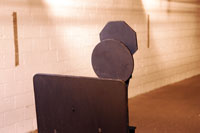 The basic function of the Bobber X-treme™ will probably sound familiar. A steel plate is presented to the shooter from behind cover. This plate can be hit at any time while it is exposed, and a computer interface is used to control the frequency and duration of the target exposures.
The basic function of the Bobber X-treme™ will probably sound familiar. A steel plate is presented to the shooter from behind cover. This plate can be hit at any time while it is exposed, and a computer interface is used to control the frequency and duration of the target exposures.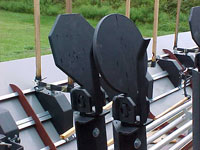 Judgment – Split-second judgment and threat analysis may be the most important elements of the training triangle. The revolutionary Bobber X-treme™ addresses this issue by presenting the shooter with two separate target plates, one directly behind the other. One plate is an 8-inch circle, and the other is an 8-inch octagon. Depending on your training scenario, you can classify all the circle plates as hostile, and all the octagon plates as friendly. When one of the plates jumps up from behind cover, the shooter must quickly determine whether the plate is hostile or friendly and then take the appropriate action. The circles and octagons look enough alike to force the shooter to be sure.
Judgment – Split-second judgment and threat analysis may be the most important elements of the training triangle. The revolutionary Bobber X-treme™ addresses this issue by presenting the shooter with two separate target plates, one directly behind the other. One plate is an 8-inch circle, and the other is an 8-inch octagon. Depending on your training scenario, you can classify all the circle plates as hostile, and all the octagon plates as friendly. When one of the plates jumps up from behind cover, the shooter must quickly determine whether the plate is hostile or friendly and then take the appropriate action. The circles and octagons look enough alike to force the shooter to be sure.